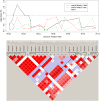A powerful nonparametric statistical framework for family-based association analyses
- PMID: 25745024
- PMCID: PMC4423382
- DOI: 10.1534/genetics.115.175174
A powerful nonparametric statistical framework for family-based association analyses
Abstract
Family-based study design is commonly used in genetic research. It has many ideal features, including being robust to population stratification (PS). With the advance of high-throughput technologies and ever-decreasing genotyping cost, it has become common for family studies to examine a large number of variants for their associations with disease phenotypes. The yield from the analysis of these family-based genetic data can be enhanced by adopting computationally efficient and powerful statistical methods. We propose a general framework of a family-based U-statistic, referred to as family-U, for family-based association studies. Unlike existing parametric-based methods, the proposed method makes no assumption of the underlying disease models and can be applied to various phenotypes (e.g., binary and quantitative phenotypes) and pedigree structures (e.g., nuclear families and extended pedigrees). By using only within-family information, it can offer robust protection against PS. In the absence of PS, it can also utilize additional information (i.e., between-family information) for power improvement. Through simulations, we demonstrated that family-U attained higher power over a commonly used method, family-based association tests, under various disease scenarios. We further illustrated the new method with an application to large-scale family data from the Framingham Heart Study. By utilizing additional information (i.e., between-family information), family-U confirmed a previous association of CHRNA5 with nicotine dependence.
Keywords: between-family information; nicotine dependence; pedigree structure; population stratification; within-family information.
Copyright © 2015 by the Genetics Society of America.
Figures


Similar articles
-
Weighted pedigree-based statistics for testing the association of rare variants.BMC Genomics. 2012 Nov 24;13:667. doi: 10.1186/1471-2164-13-667. BMC Genomics. 2012. PMID: 23176082 Free PMC article.
-
Power of family-based association designs to detect rare variants in large pedigrees using imputed genotypes.Genet Epidemiol. 2014 Jan;38(1):1-9. doi: 10.1002/gepi.21776. Epub 2013 Nov 15. Genet Epidemiol. 2014. PMID: 24243664 Free PMC article.
-
Detecting Rare Mutations with Heterogeneous Effects Using a Family-Based Genetic Random Field Method.Genetics. 2018 Oct;210(2):463-476. doi: 10.1534/genetics.118.301266. Epub 2018 Aug 13. Genetics. 2018. PMID: 30104420 Free PMC article.
-
Single Marker Family-Based Association Analysis Not Conditional on Parental Information.Methods Mol Biol. 2017;1666:409-439. doi: 10.1007/978-1-4939-7274-6_20. Methods Mol Biol. 2017. PMID: 28980257 Review.
-
Parental phenotypes in family-based association analysis.Am J Hum Genet. 2005 Feb;76(2):249-59. doi: 10.1086/427886. Epub 2004 Dec 21. Am J Hum Genet. 2005. PMID: 15614722 Free PMC article. Review.
Cited by
-
Powerful and robust cross-phenotype association test for case-parent trios.Genet Epidemiol. 2018 Jul;42(5):447-458. doi: 10.1002/gepi.22116. Epub 2018 Feb 20. Genet Epidemiol. 2018. PMID: 29460449 Free PMC article.
-
A multi-locus predictiveness curve and its summary assessment for genetic risk prediction.Stat Methods Med Res. 2020 Jan;29(1):44-56. doi: 10.1177/0962280218819202. Epub 2019 Jan 7. Stat Methods Med Res. 2020. PMID: 30612522 Free PMC article.
References
-
- Balding D. J., Nichols R. A., 1995. A method for quantifying differentiation between populations at multi-allelic loci and its implications for investigating identity and paternity. Genetica 96: 3–12. - PubMed
Publication types
MeSH terms
Grants and funding
LinkOut - more resources
Full Text Sources
Other Literature Sources

